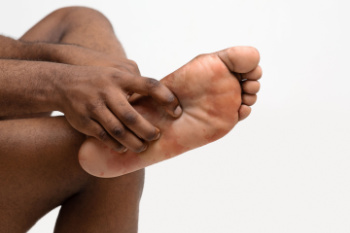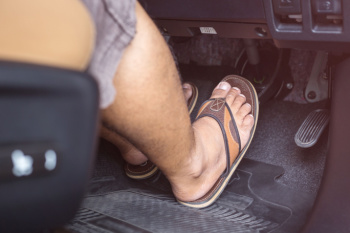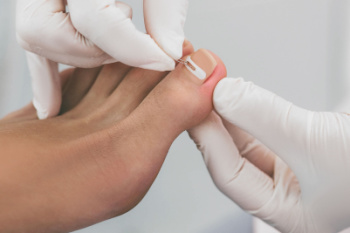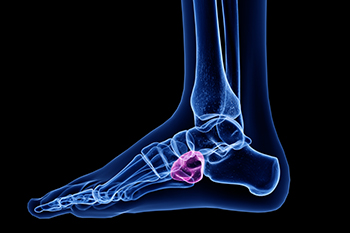November 2024
Are You Suffering From Ingrown Toenails?
Understanding Plantar Fasciitis

Plantar fasciitis is a common foot condition that causes pain in the heel and bottom of the foot. It occurs when the thick band of tissue along the sole of the foot, called the plantar fascia, becomes irritated or inflamed due to overuse, improper footwear, or excessive pressure. The hallmark symptom is sharp, stabbing pain in the heel, especially with the first steps in the morning, or after long periods of sitting. Treatment options include rest, stretching exercises, and anti-inflammatory medications. Wearing supportive shoes or using custom orthotics can also provide relief. In more severe cases, corticosteroid injections or even surgery may be necessary. A podiatrist can offer personalized advice, diagnose the condition, and recommend the best treatment plan. They can also help prevent future flare-ups by addressing underlying issues like improper gait or foot structure. If you are experiencing heel pain, it is suggested that you schedule an appointment with a podiatrist to get the care you need.
Plantar fasciitis can be very painful and inconvenient. If you are experiencing heel pain or symptoms of plantar fasciitis, contact Dr. Robert Marcus from Foot & Ankle Center of Teaneck. Our doctor can provide the care you need to keep you pain-free and on your feet.
What Is Plantar Fasciitis?
Plantar fasciitis is the inflammation of the thick band of tissue that runs along the bottom of your foot, known as the plantar fascia, and causes mild to severe heel pain.
What Causes Plantar Fasciitis?
- Excessive running
- Non-supportive shoes
- Overpronation
- Repeated stretching and tearing of the plantar fascia
How Can It Be Treated?
- Conservative measures – anti-inflammatories, ice packs, stretching exercises, physical therapy, orthotic devices
- Shockwave therapy – sound waves are sent to the affected area to facilitate healing and are usually used for chronic cases of plantar fasciitis
- Surgery – usually only used as a last resort when all else fails. The plantar fascia can be surgically detached from the heel
While very treatable, plantar fasciitis is definitely not something that should be ignored. Especially in severe cases, speaking to your doctor right away is highly recommended to avoid complications and severe heel pain. Your podiatrist can work with you to provide the appropriate treatment options tailored to your condition.
If you have any questions please feel free to contact our office located in Teaneck, NJ . We offer the newest diagnostic and treatment technologies for all your foot and ankle needs.
Understanding Driver's Foot

Driving for extended periods can lead to various types of foot and ankle pain, commonly referred to as driver's foot. One prevalent issue is pain in the heel and arch, often caused by maintaining pressure on the accelerator or brake pedals for long durations. This repetitive motion can lead to conditions such as plantar fasciitis or tendonitis. Additionally, discomfort may arise in the toes, particularly from cramped foot positions, leading to conditions like Morton’s neuroma. Drivers may also experience ankle pain due to the constant flexing and extension required for operating the pedals. Poor footwear choices can make these issues worse, as shoes lacking proper support contribute to fatigue and discomfort. If you have foot pain from driving, it is suggested that you consult a podiatrist who can offer you relief and treatment solutions.
Foot Pain
Foot pain can be extremely painful and debilitating. If you have a foot pain, consult with Dr. Robert Marcus from Foot & Ankle Center of Teaneck. Our doctor will assess your condition and provide you with quality foot and ankle treatment.
Causes
Foot pain is a very broad condition that could be caused by one or more ailments. The most common include:
- Bunions
- Hammertoes
- Plantar Fasciitis
- Bone Spurs
- Corns
- Tarsal Tunnel Syndrome
- Ingrown Toenails
- Arthritis (such as Gout, Rheumatoid, and Osteoarthritis)
- Flat Feet
- Injury (from stress fractures, broken toe, foot, ankle, Achilles tendon ruptures, and sprains)
- And more
Diagnosis
To figure out the cause of foot pain, podiatrists utilize several different methods. This can range from simple visual inspections and sensation tests to X-rays and MRI scans. Prior medical history, family medical history, and any recent physical traumatic events will all be taken into consideration for a proper diagnosis.
Treatment
Treatment depends upon the cause of the foot pain. Whether it is resting, staying off the foot, or having surgery; podiatrists have a number of treatment options available for foot pain.
If you have any questions, please feel free to contact our office located in Teaneck, NJ . We offer the newest diagnostic and treatment technologies for all your foot care needs.
What to Expect From Ingrown Toenail Surgery

Ingrown toenail surgery is a common procedure performed to alleviate the pain and discomfort of a toenail growing into the surrounding skin. This condition often results in inflammation, redness, and swelling, making it difficult to walk. The surgery typically involves removing the portion of the toenail that is embedded in the skin, which can provide immediate relief. In some cases, the podiatric surgeon may also remove a small section of the nail matrix to prevent recurrence. The procedure is usually performed under local anesthesia, allowing patients to remain awake but pain-free during the operation. After surgery, proper wound care is necessary to promote healing and prevent infection. If you have an infected ingrown toenail, it is suggested that you consult a podiatrist who can determine if this type of foot surgery is right for you.
Foot surgery is sometimes necessary to treat a foot ailment. To learn more, contact Dr. Robert Marcus of Foot & Ankle Center of Teaneck. Our doctor will assist you with all of your foot and ankle needs.
When Is Surgery Necessary?
Foot and ankle surgery is generally reserved for cases in which less invasive, conservative procedures have failed to alleviate the problem. Some of the cases in which surgery may be necessary include:
- Removing foot deformities like bunions and bone spurs
- Severe arthritis that has caused bone issues
- Cosmetic reconstruction
What Types of Surgery Are There?
The type of surgery you receive will depend on the nature of the problem you have. Some of the possible surgeries include:
- Bunionectomy for painful bunions
- Surgical fusion for realignment of bones
- Neuropathy decompression surgery to treat nerve damage
Benefits of Surgery
Although surgery is usually a last resort, it can provide more complete pain relief compared to non-surgical methods and may allow you to finally resume full activity.
Surgical techniques have also become increasingly sophisticated. Techniques like endoscopic surgery allow for smaller incisions and faster recovery times.
If you have any questions please feel free to contact our office located in Teaneck, NJ . We offer the newest diagnostic and treatment technologies for all your foot and ankle needs.
Cuboid Syndrome and Pain on the Outside of the Foot

Cuboid syndrome is a condition characterized by pain on the outer side of the foot, often resulting from the misalignment of the cuboid bone. This small bone plays a vital role in foot stability and movement. The pain typically arises during activities that involve weight-bearing or lateral movements. Common causes of cuboid syndrome include ankle sprains, overuse injuries, and improper footwear, which can lead to strain on the surrounding ligaments. Additionally, repetitive activities, such as running or jumping, may contribute to this cuboid syndrome. People with flat feet or high arches are also at greater risk due to altered foot mechanics. If you have pain in this part of your foot, it is suggested that you contact a podiatrist who can provide an accurate diagnosis and treatment.
Cuboid syndrome, also known as cuboid subluxation, occurs when the joints and ligaments near the cuboid bone in the foot become torn. If you have cuboid syndrome, consult with Dr. Robert Marcus from Foot & Ankle Center of Teaneck. Our doctor will assess your condition and provide you with quality foot and ankle treatment.
Cuboid syndrome is a common cause of lateral foot pain, which is pain on the outside of the foot. The condition may happen suddenly due to an ankle sprain, or it may develop slowly overtime from repetitive tension through the bone and surrounding structures.
Causes
The most common causes of cuboid syndrome include:
- Injury – The most common cause of this ailment is an ankle sprain.
- Repetitive Strain – Tension placed through the peroneus longus muscle from repetitive activities such as jumping and running may cause excessive traction on the bone causing it to sublux.
- Altered Foot Biomechanics – Most people suffering from cuboid subluxation have flat feet.
Symptoms
A common symptom of cuboid syndrome is pain along the outside of the foot which can be felt in the ankle and toes. This pain may create walking difficulties and may cause those with the condition to walk with a limp.
Diagnosis
Diagnosis of cuboid syndrome is often difficult, and it is often misdiagnosed. X-rays, MRIs and CT scans often fail to properly show the cuboid subluxation. Although there isn’t a specific test used to diagnose cuboid syndrome, your podiatrist will usually check if pain is felt while pressing firmly on the cuboid bone of your foot.
Treatment
Just as the range of causes varies widely, so do treatments. Some more common treatments are ice therapy, rest, exercise, taping, and orthotics.
If you have any questions, please feel free to contact our office located in Teaneck, NJ . We offer the newest diagnostic and treatment technologies for all your foot care needs.






